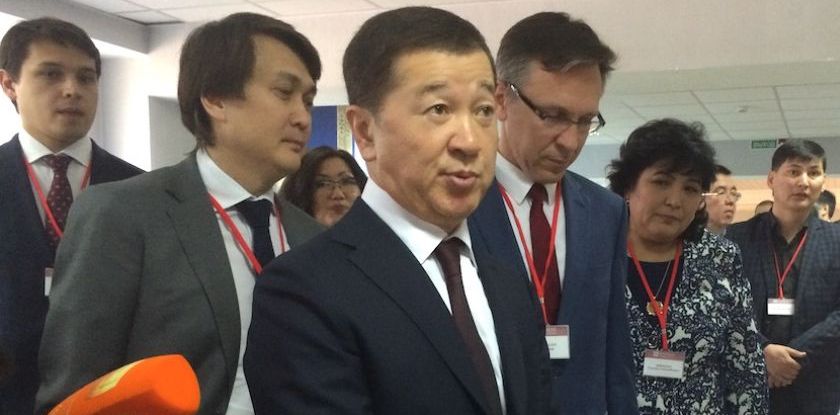Kazakhstan is continuing to save private banks belonging to the oligarchs from Nursultan Nazarbayev’s closest circle. This time, it is Fortebank whose end beneficiary is thought to be Bulat Ytemuratov, the former Head of the Presidential Affairs Department.
On October 1, 2018, citing the press-service of Samruk-Kazyna JSC, the Kazakhstan media-resources released information that the state holding and Fortebank JSC had signed an agreement on converting a 220 bln deposit into the bank’s long-term bonds.
Since we were unable to find the press-release on the state holding’s website, we will use the publication of Fortebank JSC. We will quote it in its entirety (text in bold by kz.expert).
«ForteBank and Samruk-Kazyna Expand Cooperation
ForteBank JSC and Samruk-Kazyna National Welfare Fund JSC have signed an agreement within the framework of which Fortebank is to buy the debt securities of Samruk-Kazyna, Kazakhstan Temir Zholy NC JSC, National Atomic Company Kazatomprom and to provide its operational services to the companies of the Samruk-Kazyna Group.
«We are happy to continue our long-term partnership with Samruk-Kazyna and are certain that our cooperation will ensure the effective implementation of the strategic projects in providing loans to the real sector of the economy. Keeping its leadership in terms of the capital sufficiency and liquidity in the country, in 2018, ForteBank is demonstrating steady growth of all the financial and operational results. The agreement with Samruk-Kazyna, Kazakhstan Temir Zholy, and Kazatomprom significantly strengthens ForteBank’s standing in Kazakhstan’s corporate segment», says ForteBank’s Chairman Guram Andronikashvili.
As part of the agreement with ForteBank, Samruk-Kazyna has converted its 220 bln tenge deposit into the bank’s long-term bonds. In its turn, ForteBank is buying Samruk-Kazyna’s and Kazakhstan Temir Zholy’s securities in the amount of 150 bln tenge and National Atomic Company Kazatomprom’s securities in the amount of up to 200 $ mln. The transactions with Kazakhstan Temir Zholy and Samruk-Kazyna have been completed, the Kazatomprom transaction is to be completed in the nearest future».
If we factor out all the noise about Fortebank’s leadership in terms of the capital sufficiency and liquidity and the expanding cooperation with Samruk-Kazyna in providing loans for the realization of the strategic projects in the real sector of the economy, one thing becomes clear — yet another big player of the country’s banking sector has found itself in difficult circumstances.
And all because Samruk-Kazyna and its affiliated companies have massively withdrawn their deposits from commercial banks.
Of course, contrary to the Tsesnabank case, here the Government and the National Bank as well as the top-management of Samruk-Kazyna are acting much wiser from the legal standpoint. In other words, instead of simply sanctioning the deposits withdrawal, they have stirred up an operation that, in the business circles of the 1990s, used to be called a «dummy run».
As a result of this «dummy run», the 220 bln tenge deposit of the state holding and its two big affiliated companies has been converted into Fortebank’s bonds. It its turn, with all the «unexpectedly found» cash, the latter has bought Samruk-Kazyna’s and Kazakhstan Temir Zholy’s securities in the amount of 150 bln tenge and will additionally buy Kazatomprom’s securities in the amount of 200 $ mln.
The essence of this financial trick is that now Fortebank has the legal right to obtain loans from the National Bank of Kazakhstan on the pledge of the quasi-state companies’ securities.
Basically, this is exactly what was done with Tsesnabank that, in order not to «drown», had asked for a temporary aid from the Regulator in the amount of 150 bln tenge (and got it), and then received 450 bln of the fundamental aid from the Government. Here, on paper, it does not look like the Regulator is rescuing Fortebank from its problems but is simply completing a regular operation of supporting the liquidity of the bank against the pledge of the liquid securities.
It looks like Akorda has finally learned something from the Tsesnabank’s resonant case when, due to the information leak, the second-largest bank in the country in terms of its size had found itself on the verge of bankruptcy in just ten days. To save it, the Government and the National Bank had to violate President Nazarbayev’s explicit order not to use the state funds for the «drowning» banks’ rescue.
We cannot say what has played the crucial role in the recent case — the influence of Fortebank’s end beneficiary Bulat Utemuratov or simply this negative experience. But the conclusion which offers itself at once is this — the Kazakhstan authorities learn only from their own mistakes.





rita sammut
I have 146 shares in fortebank jsc gdr. I would like to know what is their value today.